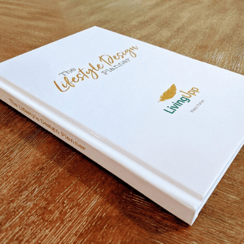Roughly 40% of Americans struggle with insomnia. And if you happen to be one of them, you know that not getting enough restful sleep can take a toll on your health. Worries over finances, job insecurity, and relationship problems are often associated with poor sleep patterns. But long-term shortages can lead to more serious things like depression, higher alcohol consumption, and even accidents.
Giving your body a chance to fully recover from the daily grind is essential for good health, and sometimes that requires finding creative ways deal with your spinning thoughts before bedtime.
There are many different sleep aids and medications on the market to treat insomnia, but many of them also have undesirable consequences, such as lightheadedness and constipation. Journaling, on the other hand, is a simple self-care practice that has been shown to promote better sleep, without the unwanted side effects.
In this article, we’ll explore how journaling can help you get better sleep.
Troubleshooting Insomnia
Knowing what’s keeping you up at night is the first step to address insomnia. Before you can choose the right solution, you’ll need to zero in the source of the problem. Sometimes medical conditions play a role in sleep disturbances, and it’s best to consult with your doctor to determine if a referral to a sleep specialist is needed.
But sometimes your journal can help you uncover contributing factors, and provide your doctor with more information.
Troubleshooting insomnia requires examining your daily habits to uncover what might be interfering with your sleep. Within the pages of your journal, you can retrace your choices throughout the day to see if there are any repeating patterns. For example, do you struggle with falling asleep more on the days that you have that extra afternoon cup of coffee? Or do you wake up frequently in the middle of the night thinking about a disagreement you had with a colleague?
Journaling can help you identify changes in your sleep patterns, and that can offer some clues about what’s getting in the way of your sleep. One way you can use your journal is to keep a log of what time you go to bed and how many hours of sleep you get each night. Many devices such as the Fitbit have this feature built in, but it’s still up to you to interpret the findings and make necessary connections and adjustments. After taking a closer look at your daily patterns, you might just find that your thoughts are playing a bigger role than you realized.
Understanding Your Rhythms
The National Institute of General Medical Sciences describes circadian rhythms as “physical, mental, and behavioral changes that follow a 24-hour cycle.”
The first known scientist to study circadian rhythms was Jean-Jacques d'Ortous de Mairan of France. He discovered that the leaves of plants followed a specific rhythm whether or not they were exposed to light.
These hard-wired rhythms are your body’s preferred operating schedule, and they vary from person to person. That’s why some people describe themselves as being night owls and others early birds. Understanding your circadian rhythms can offer more insights about how to best structure your day to optimize sleep. And journaling can help you uncover those preferences.
Journaling for Improved Sleep Quality
Researchers have studied the effects of journaling on sleep disturbances, and their findings suggest that keeping a journal is an easy and useful method for addressing insomnia. Creating a sleep journal can help you better understand your circadian rhythms, as well make the necessary lifestyle changes to get more rest.
To get started, here are a few ways you can use your journal to improve the quality of your sleep.
Relaxation
For many people, it’s difficult to unwind after a stressful day of endless demands and responsibilities. As a result, the evening hours are often filled with high-calorie snacks, binging on favorite TV shows, and scrolling through social media feeds—not exactly the kinds of activities that promote good sleep. In contrast, journaling can help you release the events of the day, along with the strong emotions and spinning thoughts that often accompany them.
Drifting Off to Sleep
Research has suggested that nighttime journaling can help you fall asleep faster. The same goes for list-making. A 2018 study found that writing out a to-do list for the next day can help you relax and drift off to sleep more quickly. Some experts believe it’s because this practice may help offload worries about things falling through the cracks. And putting those important tasks on a to-do list means you’ll be less likely to forget about them, which may put your mind at ease enough to drift off to sleep.
Falling Back to Sleep
But even if you do manage to fall asleep, what if you find yourself wide awake again in the middle of the night? The good news is, journaling has been found to help you fall back to sleep as well.
Creating a Sleep Journal
Julia Cameron outlined a simple journaling process she calls “morning pages” in her book The Artist’s Way. These morning pages serve many purposes, from setting the tone for your day to processing your thoughts. But “night notes” can also be an effective way to release the day’s worries and racing thoughts before you crawl into bed. Here’s how to create a sleep journal of your own:
Choose a Journal
Researchers have found that good old-fashioned pen and paper is more effective than apps when it comes to realizing the benefits of journaling. Some researchers believe that the blue light from digital devices could interfere with sleep. Choose a journal with a calming cover and a design that’s appealing to you.
Choose a Location
Place your journal in a location where you spend the most time in the evenings just before bed. For most people this is somewhere near your bed, such as a chair or bedside table. If you don’t already have a designated space to unwind in the evening, it might be worth creating one. A corner nook in a quiet room can be easily converted to a journaling space by adding some good soft lighting and a soft, comfy chair.
Choose a Format
When it comes to creating new habits, the simpler the better. When the behavior doesn’t require much thinking or energy, you’re more likely to follow through consistently. Choose a journaling format that doesn’t have a lot of rules, such as freestyle journaling. This approach can help you find your flow in translating your thoughts out onto the pages.
Journaling Prompts
If freestyle journaling doesn’t come naturally for you, here are a few structured prompts to help you get started with your sleep journal:
· What’s on my mind right now is…
· What I need to do tomorrow is…
· I can’t stop thinking about…
· What I really want is…
· What worries me most is…
Summary
Getting sufficient amounts of restful sleep is essential for your well-being. While there are many different ways you could address difficulties with sleep, journaling is an easy approach
that doesn’t carry many of the unwanted side effects that others do. Journaling can help you put your swirling thoughts and worries to bed, so you can get the rest you need.
Information contained in this article is for educational purposes only and should not be interpreted as providing or replacing medical advice, diagnosis, or treatment.

Author bio: STACY FISHER, RDN, LD, CDCES is the founder of LivingUpp™, a lifestyle design company that teaches women how to use a self-care planning  system to create more ease and better health. She is a registered dietitian and lifestyle coach with 20+ years of experience in the healthcare industry, where she’s worked with large companies such as Dell, Boeing and Nike. Stacy is the author of Go: One Woman. One Van. A New Beginning and The Lifestyle Design Planner, a flexible life organizer for high-achievers who value self-care and simplicity.
system to create more ease and better health. She is a registered dietitian and lifestyle coach with 20+ years of experience in the healthcare industry, where she’s worked with large companies such as Dell, Boeing and Nike. Stacy is the author of Go: One Woman. One Van. A New Beginning and The Lifestyle Design Planner, a flexible life organizer for high-achievers who value self-care and simplicity.



Leave Comment